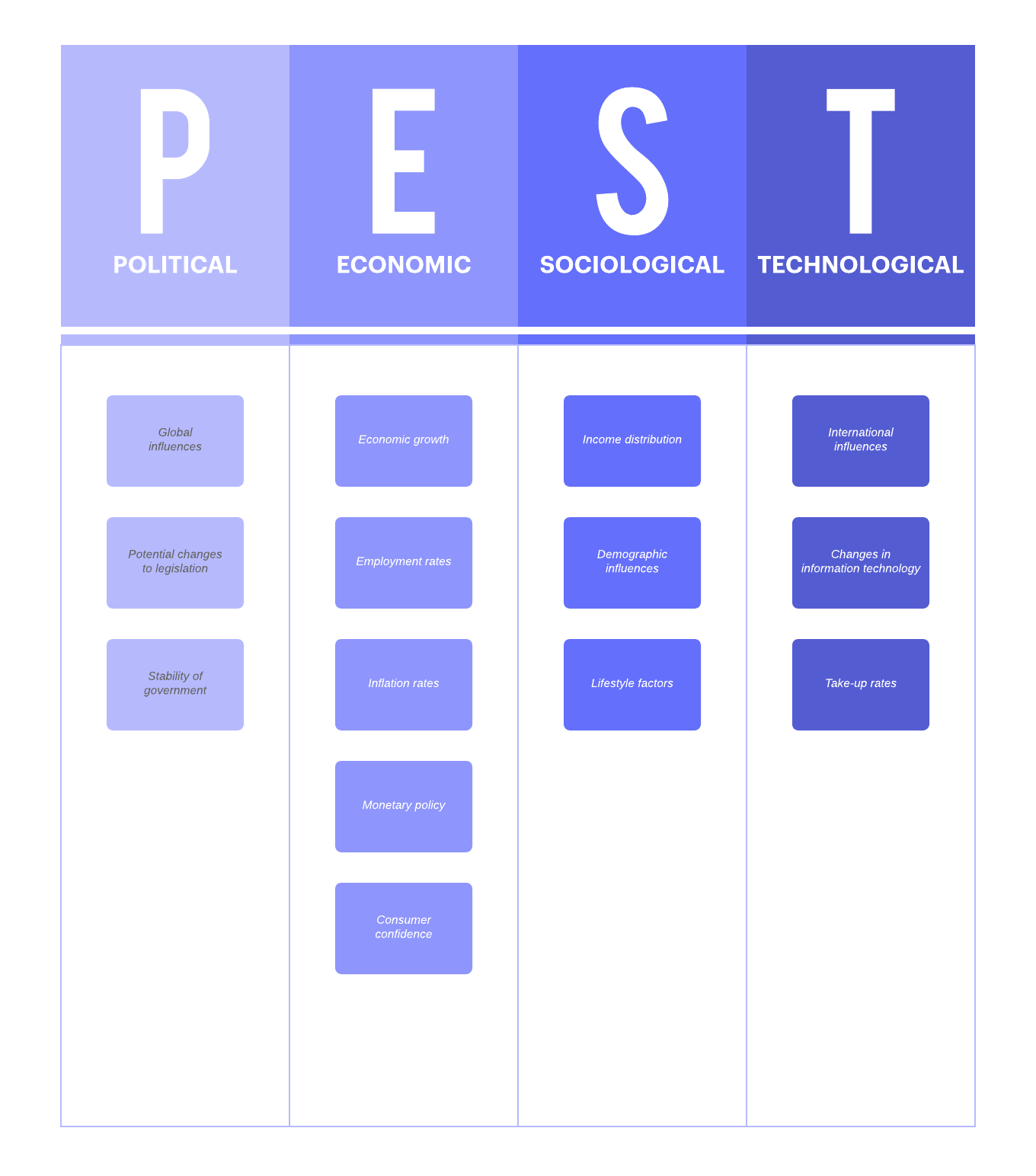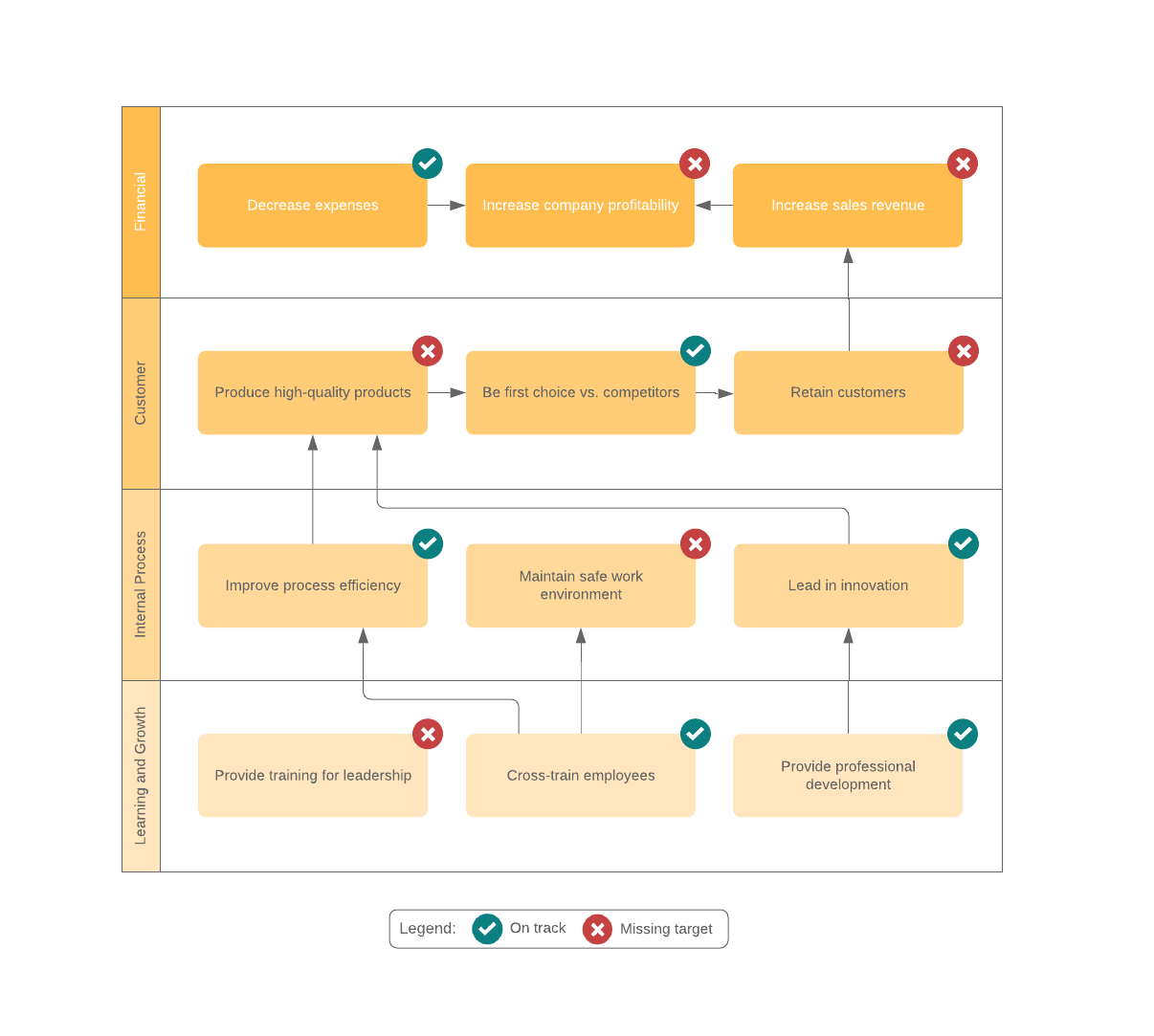As a business leader, you understand the importance of staying ahead of the curve, but changes outside your control are constantly influencing your business. If you don’t take the time to identify and understand these external factors, you could be leaving money on the table—or worse, endangering the business itself.
The PEST analysis helps entrepreneurs discover what factors could impact their business and develop strategies to handle those changes. In this article, you will learn the of a PEST analysis and how to complete one.

What is a PEST analysis?
Originally developed in 1967 by Harvard professor Francis Aguilar, PEST analysis is a strategic planning tool that helps organizations identify and evaluate threats and opportunities for the business.
PEST is an acronym describing four primary external factors that influence the business environment: political, economic, socio-cultural, and technological.
There are a few variations of this analysis including the PESTLE analysis, which also considers legal and environmental factors.
Goals of a PEST analysis
The main purpose of PEST analysis is to understand what external forces may affect your organization and how those factors could create opportunities or threats to your business.
PEST analysis helps you:
- Understand current external influences on the business so you can work on facts rather than assumptions.
- Identify what factors could change in the future.
- Mitigate risks and take advantage of opportunities to remain competitive.
- Develop a better long-term strategy.
PEST is particularly useful for understanding the overall market environment. The more threats or risk factors in the market, the more difficult it is to do business. By analyzing the market forces at play, the more strategic you can be in your planning and decision-making.
Additionally, PEST analysis helps organizations strategically plan projects and initiatives so that you only focus on projects that have the greatest chance of success. It also gives you the tools to forecast changes so you can grow your organization with those changes instead of working against them.
PEST vs. SWOT analysis
PEST and SWOT analysis are often used together to better understand the business environment. However, the two frameworks are distinct and apply to different levels of business analysis.
PEST analysis focuses on the big picture and impacts on the overall business, market, and important decisions. PEST is best used for market research and broader analysis of the business environment.
On the other hand, SWOT analysis hones in more narrowly on the organization itself to identify its strengths, weaknesses, opportunities, and threats. A SWOT analysis is often conducted at the beginning of a new project or to evaluate a product line.

Combining these macro- and micro-level analyses of your business will help you understand a complete picture of your market and your business’s unique opportunities so you can mitigate risks and effectively plan for the future.
When to do a PEST analysis
A PEST analysis is best used when you need a big-picture understanding of your business. Some of the best times to do a PEST analysis include:
- When you’re starting a new business
- When you uncover a major problem
- When/if your business is pivoting
- When you recognize impending changes in one area (e.g., politics) and want to re-evaluate the market
Keep in mind that PEST analyses are macro-level evaluations.
How to do a PEST analysis
Conducting a PEST analysis is fairly straightforward, but it can be time-consuming. Use the following steps to help you conduct your next PEST analysis—just be sure to give yourself plenty of time to do a thorough evaluation.
1. Consider PEST factors that could impact your business
The first step is to research and gather as much information about your organization’s external influences as possible. Enlist the help of other leaders or managers in the business to ensure you have a comprehensive data set.
As you start brainstorming and gathering data, consider the following list of PEST examples to guide your research:
P: Political factors
Political factors look at how legal and governmental regulations, as well as the political climate, might affect your organization’s freedom to operate and its ultimate profitability.
These factors might include:
- Upcoming local, state, or national elections
- Main political candidates and their views on different policies
- Government regulation of industry or competition
- Trade policies (e.g., tariffs, current or prospective trade deals, etc.)
- Level of corruption or organized crime in your region or country
- Import restrictions
- E-commerce policies
- Consumer and employee protections
E: Economic factors
The economy has a significant impact on any business. Consider the following economic factors that could influence your business operations:
- Current economic stability
- Projected growth and inflation rates
- Interest rates
- Fiscal policies
- Consumer habits and financial stability
- Unemployment rate and competition for jobs
- Access to credit (personal and business)
S: Socio-cultural factors
Socio-cultural factors consider the makeup of the population and your target demographics to understand how well your business can compete in the market. These factors might include age distribution, cultural attitudes, and workplace or lifestyle trends.
As you analyze the market, consider how the following factors could impact your organization:
- Population growth and demographics
- Generational shifts
- Consumer habits and values (e.g., focus on product quality or eco-friendliness)
- Family size and structure
- Consumer lifestyles
- Immigration rates
- Attitudes toward work
T: Technological factors
This step considers technology’s specific role and development in an organization and the industry, as well as broader technological trends and uses that affect society as a whole.
For example, one way technological changes have affected the workforce is by increasing access and availability of remote working opportunities. These changes have far-reaching consequences for the future of work and will impact how organizations structure their businesses and employees.
Other technological factors to consider include:
- The organization’s access to new technology
- The competition’s access to technology
- Rate of technological change
- Evolution of infrastructure
- Government or institutional research
2. Identify opportunities
Once you’ve researched the various ways your organization is influenced and affected by external conditions, start identifying opportunities these changes could provide.
For instance, is there a technological development of which you could take advantage to increase efficiency? Or are there shifts in consumer demographics that could open new markets for your products?
Seek out as many opportunities as possible so you can develop the best strategic response for your business.
3. Identify threats
Unfortunately, change also comes with risks. Whether an economic downturn threatens your bottom line or a competitor’s access to new technology gives them a competitive edge, you need to identify potential threats to your organization so you can mitigate the risks and adapt your strategy accordingly.
The sooner you recognize threats, the more likely you are to avoid them or reduce their impact.
4. Act on your findings
With all your data collected and your opportunities and threats outlined, it’s time to take action. Incorporate these findings into your business plan to take advantage of opportunities and manage threats as soon as possible.

Use Lucidchart for your next PEST analysis
When it comes to PEST analysis, there are a lot of things to consider. Make the process easier with Lucidchart.
Lucidchart is an intelligent diagramming solution that helps businesses visualize their processes, people, and systems. Use Lucidchart’s ready-made business analysis and strategy templates to get started on your analysis today. Because Lucidchart is a cloud-based platform, you can work from multiple devices and easily share your documents with other contributors.
When you’re finished, start a new diagram in Lucidchart to map out your strategy so you can begin taking action on your findings ASAP.

Browse Lucidchart's business analysis and strategy templates. Go now
Browse Lucidchart’s business analysis and strategy templates.
Go nowAbout Lucidchart
Lucidchart, a cloud-based intelligent diagramming application, is a core component of Lucid Software's Visual Collaboration Suite. This intuitive, cloud-based solution empowers teams to collaborate in real-time to build flowcharts, mockups, UML diagrams, customer journey maps, and more. Lucidchart propels teams forward to build the future faster. Lucid is proud to serve top businesses around the world, including customers such as Google, GE, and NBC Universal, and 99% of the Fortune 500. Lucid partners with industry leaders, including Google, Atlassian, and Microsoft. Since its founding, Lucid has received numerous awards for its products, business, and workplace culture. For more information, visit lucidchart.com.
Related articles
9 essential business analysis models for the BA’s toolbox
A great business analyst is armed with a toolbox of visual modeling techniques to help them drive successful project outcomes. In this article, you'll find nine of the best techniques, including process flows and SWOT analysis diagrams.
SWOT vs Gap Analysis: Strategies to Analyze Your Business’s Health
What’s the best approach to analyzing your business? Learn the differences between SWOT analysis and gap analysis, and see how either method can help you identify your business's strengths and areas to improve.

